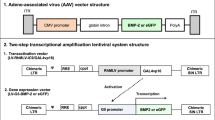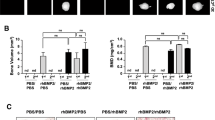Abstract
It has been well established that bone morphogenetic protein-2 (BMP-2) can induce bone formation bothin vivo andin vitro, although high concentrations (up to milligrams) of BMP-2 have been required to achieve this effectin vivo. Further, clinical applications are usually limited to a single dose at the time of implantation. In an attempt to prolong the transforming effect of BMP-2 we used a recombinant adenoviral vector carrying the human BMP-2 gene (Adv-BMP2) to transduce marrow-derived mesenchymal stem cells (MSC) of skeletally mature male New Zealand white rabbits. The pluripotential MSC were incubated with Adv-BMP2 overnight followed by culture in growth medium for 1 week. Assays on tissue cultures demonstrated that these Adv-BMP2 transduced MSC produced BMP-2 protein, differentiated into an osteoprogenitor line, and induced bone formationin vitro. These MSC had increased alkaline phosphatase activity, increased expression of type I collagen, osteopontin, and osteocalcin mRNA, and induced matrix mineralization compared with both nontransduced cells and cells transduced with a control adenoviral construct. To analyze the osteogenic potentialin vivo, Adv-BMP2-transduced MSC were autologously implanted into the intertransverse process space between L5 and L6 of the donor rabbits. The production of new bone was demonstrated by radiographic examination 4 weeks later in areas implanted with cells transduced with Adv-BMP2, whereas no bone was evident at sites implanted with cells transduced with the control adenoviral construct. Histological examination further confirmed the presence of new bone formation. These accumulated data indicate that it is possible to successfully transduce mesenchymal stem cells with a recombinant adenoviral vector carrying the gene for BMP-2 such that these cells will produce BMP-2, differentiate into an osteoprogenitor line, and induce bone formation bothin vitro andin vivo. Moreover, incubation of the Adv-BMP2-transduced cells for an additional 7 days in culture before transplantation enhances the success rate in bone formation (three out of three) as compared with our previous report (one out of five, Calcif Tissue Int 63:357–360, 1998).
Similar content being viewed by others
References
Wozney JM, Rosen V, Celeste AJ, Mitsock LM, Whitters MJ, Kriz RW, Hewick RM, Wang EA (1988) Novel regulators of bone formation: molecular clones and activities. Science 242:1528–1534
Rosen V, Thies RS (1992) The BMP proteins in bone formation and repair. Trends Genet 8:97–102.
Urist MR (1997) Bone morphogenetic protein: the molecularization of skeletal system development. J Bone Miner Res 12:343–346
Lecanda F, Avioli LV, Cheng S-L (1997) Regulation of bone matrix protein expression and induction of differentiation of human osteoblasts and human bone marrow stromal cells by bone morphogenetic protein-2. J Cell Biochem 67:386–398
Boden SD, Moskovitz PA, Morone MA, Toribitake Y (1996) Video-assisted lateral intertransverse process arthrodesis. Validation of a new minimally invasive lumbar spinal fusion technique in the rabbit and nonhuman primate (rhesus) models. Spine 21:2689–2697
Sandhu HS, Kanim LE, Kabo JM, Toth JM, Zeegen EN, Liu D, Delamarter RB, Dawson EG (1996) Effective doses of recombinant human bone morphogenetic protein-2 in experimental spinal fusion. Spine 21:2115–2122
Morone MA, Boden SD, Hair G, Martin GJ Jr, Racine M, Titus L, Hutton WC (1998) The Marshall R. Urist Young Investigator Award: Gene expression during lumbar spine fusion and the effect of bone morphogenetic protein 2. Clin Orthop Rel Res 351:252–265
Lou J, Xu F, Merkel K, Manske P (1999) Gene therapy: adenovirus-mediated human bone morphogenetic protein-2 gene transfer induces mesenchymal progenitor cell proliferation and differentiationin vitro and bone formationin vivo. J Orthop Res 17:43–50
Riew KD, Wright NM, Cheng S-L, Avioli LV, Lou J (1998) Induction of bone formation using a recombinant adenoviral vector carrying the human BMP-2 gene in a rabbit spinal fusion model. Calcif Tissue Int 63:357–360
Wozney JM (1989) Bone morphogenetic proteins. Prog Growth Factor Res : 167–280
Yasko AW, Lane JM, Fellinger EJ, Rosen V, Wozney JM, Wang EA (1992) The healing of segmental bone defects, induced by recombinant human bone morphogenetic protein (rhBMP-2). A radiographic, histological, and biomechanical study in rats. J Bone Joint Surg 74:659–670
Muschler GF, Hyodo A, Manning T, Kambic H, Easley K (1994) Evaluation of human bone morphogenetic protein 2 in a canine spinal fusion model. Clin Orthop Rel Res 308:229–240
Yang Y, Nunes FA, Berencsi K, Furth EE, Gonczol E, Wilson JM (1994) Cellular immunity to viral antigens limits E1-deleted adenoviruses for gene therapy. Proc Natl Acad Sci USA 91:4407–4411
Kinne RW, Palombo-Kinne E, Emmrich F (1997) T-cells in the pathogenesis of rheumatoid arthritis. Villains or accomplices? Biochim Biophys Acta 1360:109–141
Deodhar AA, Woolf AD (1996) Bone mass measurement and bone metabolism in rheumatoid arthritis: a review. Br J Rheumatology 35:309–322
Stein GS, Lian JB, Owen TA (1990) Relationship of cell growth to the regulation of tissue-specific gene expression during osteoblast differentiation. FASEB J 4:3111–3123
Gorski JP (1992) Acidic phosphoproteins from bone matrix: a structural rationalization of their role in biomineralization. Calcif Tissue Int 50:391–396
Boskey AL (1995) Osteopontin and related phosphorylated sialoproteins: effects on mineralization. Ann NY Acad Sci 760:249–256
Termine JD, Robey PG (1996) Bone matrix proteins and the mineralization process. In: Favus MJ (ed) Primer on the metabolic bone diseases and disorders of mineral metabolism. Lippincott-Raven, Philadelphia, pp 24–28
Bourdeau JE, Hesselton RA (1988) Serum calcium concentrations in wild rabbits. Miner Electrolyte Metab 14:253–256
Author information
Authors and Affiliations
Additional information
SLC, JL, and NMW have contributed equally to this work and therefore should be considered first authors.
Rights and permissions
About this article
Cite this article
Cheng, SL., Lou, J., Wright, N.M. et al. In Vitro andIn Vivo induction of bone formation using a recombinant adenoviral vector carrying the human BMP-2 gene. Calcif Tissue Int 68, 87–94 (2001). https://doi.org/10.1007/BF02678146
Received:
Accepted:
Published:
Issue Date:
DOI: https://doi.org/10.1007/BF02678146




